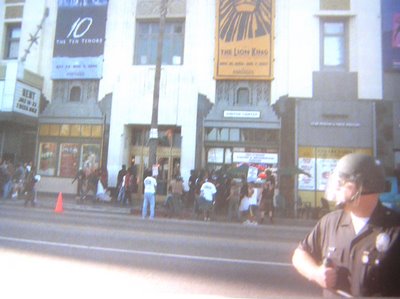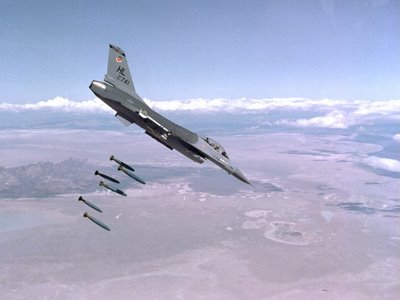

Two weeks ago, while walking home on Hollywood Boulevard I heard distant drums. As I passed Vine Street I found a demonstration and counter-demonstration in my path. The Minutemen were staging a rally for their racist anti-immigrant crusade. An organization like the KKK, but much more active, the Minutemen are a jingoist vigilante group tolerated if not encouraged by the State, as unaccountable civilian border police.
The Minutemen were on the east corner, on top of Jerry Lewis's star, while the counter-demonstrators were on the west corner, on top of Frank Borzage's star. The Minutemen were organized and about 150 strong, and were met with an equal number in opposition, impromtu though, chanting "down, down, down with the Minutemen!!" Both parties were pressed to edge of their respective curbs. The police were doing formations in the middle of the street between the two groups, however they always faced the opposition, the counter-demonstrators, batons drawn. Every 10 minutes or so the police would shift positions in maneuver-like fashion, lending the scene a theatrical air.
Someone from the counter-demonstration stepped down off of the curb accidentally and the pigs started clubbing us with all their strength. The victims were mainly women. Afterwards, as everyone on our side cursed the police and threw plastic bottles at them, I saw the physical consequences of the police clubbing on those at the very front: knees swollen the size of baseballs. In the now indignant atmosphere several young counter-demonstrators tried to cross the street in dispersion and were immediately sacked by multiple cop, with typical pig historionics: 2 or 3 corn-fed flat-foots pinned and ground one female counter-demonstrator into the asphalt. Several minutes later the police began beating a protester who had successfully crossed the street (see video by clicking above photo). They caught him by his shirt, dragged him around by it, and several different brutal pigs took turns with their batons. A young couple tried to shield the sacked protester from the baton blows, only to receive their own. The pigs cuffed the street-crosser, picked him up high and slammed his chest into the ramp of a truck unloading stage apparatus for the theatrical musical 'RENT'. In all this the pigs made a point to shout "resisting arrest" (for the crossing of the street).
I took the above picture from across the street with a disposable film camera. Note the title on the theatre marquee; the duty of the
police in a capitalist state is to protect private property -- the duty of
art in a capitalist state is to be private property! Proof: this theatre will certainly pay no mind to the theatre in the street or its casualties; it exclusively puts on Broadway superproductions about "getting better all the time."
Zach Campbell recently noted Pasolini's siding with the police during May '68 in France because the police are necessarily of the working class, batons and all. Here is a response to that troubling point of view:
"We saw that an essential characteristic of the state is the existence of a public force differentiated from the mass of the people. (...) The free Athenian considered police duty so degrading that he would rather be arrested by an armed slave than himself have any hand in such despicable work."-Chapter V. of Origins of the Family, Private Property, and the State
F. Engels
In turn, the police must differentiate themselves from the State to gain any respect in these struggles.
Demonstrators might make the cop think twice about his/her job with formations and maneuvers of their own.



























